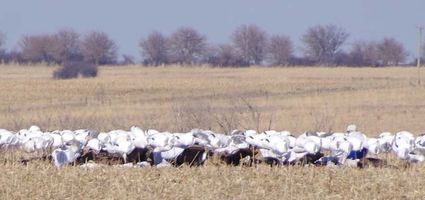Editor's Notebook
March 4, 2021
Readers are vital to the success of a newspaper. If newspapers were not read, there would be no need to prepare a newspaper but the importance of readers does not stop with reading. They are also the eyes and ears of a newspaper.
We rely on our readers to keep us posted on what is happening in the communities we serve. If you are missing something that was once part of the this newspaper, it is most likely missing because those who once submitted the stories are no longer doing so.
We appreciate all the submissions and try to follow up on all news tips.
Sometimes the tips lead to a story and sometimes they don't. An example of this happened on Saturday.
Saturday afternoon a reader called to tell us a large flock of sandhill cranes was grazing in a field directly north of the Lovewell Lake cabin area.
Knowing the cranes might not stay in that field for long, this editor and his wife immediately headed to the lake area with our telephoto camera equipment.
As we approached the cabin area from the west, we saw what appeared to be large white birds feasting in a field. We didn't recognize the birds but knew they were not sandhill cranes. Rita and I have both gone to the Platte Valley to view the annual crane migration. The cranes we have observed in the Platte Valley are more gray than white in color. And these birds seemed to be larger than the snow geese staying at the reservoir. Unsure of what they were and not wanting to have them take flight before we made our pictures, we parked and used a row of big round bales as a blind.
While studying the birds, we noticed they were strangely quiet. Unlike the thousand of snow geese on the reservoir that were constantly quacking, these birds were not only not making noise, they were not moving. Even the ones apparently in flight were stationary.
We realized we had been had. We were trying to sneak up upon and photograph a field of decoys.
Reminded me of the time I was serving as a photographer for the Kansas State University student newspaper. Each Tuesday I was responsible to photographically cover news events that involved the student body. As the photographer of the day, I had to stay in close contact with the Collegian news room and be ready to respond as the news unfolded. Consequently, I carried a brief case stuffed with camera equipment so I was ready at a moment's notice. Having the camera ready allowed me to take a picture of an older woman riding a motorcycle on which she placed a sign warning other drivers the rider was a beginner. My editor liked that photo so much it ran three columns wide near the top of that day's front page.
It was after 10 p.m. when my editor sent me to a disturbance in east Manhattan. En-route, I wasn't sure what I would find but I knew fire would most likely be part of the story for the flames were visible in the eastern sky.
I encountered a group of hysterical college students jabbering about being threatened and ordered out of the area by a wildman.
Knowing I was expected to return with a photo, I decided to move closer on foot. I encountered the "wildman" who didn't seem so wild. He explained the fire was a planned burn of a Flint Hills pasture and he had ordered the college students gathering to watch the fire to leave the area because their vehicles were blocking his driveway and it was about time for him to leave for work.
Whatever I got for a picture that night was never used in the newspaper, but I have not forgotten the experience.
Rick Solberg, another Collegian photographer, was more fortunate. The colored picture he took one night of a Flint Hills pasture fire was printed in Life magazine.
Because of procrastination, I missed my opportunity for a Life magazine photo. A New York governor and presidential candidate had spoken at Kansas State University that morning. A Life spokesman called late in the afternoon and described a photo the magazine wanted to purchase. If a Collegian photographer had made such a photo, it was to be scanned and wired to New York immediately. I had taken pictures that morning but had not yet developed my film. I had the desired photo but there wasn't time left to develop the film, dry it, print it, dry the print and put the scanned print on the wire.
The photographic process has changed greatly since that day in 1968. With today's digital equipment it would be much easier to ship the image New York.
Because of those changes, we likely will print an eagle picture in this week's newspaper. After concluding the cranes feeding were just decoys, Rita and I decided to try and photograph other birds in the lake area.
Rita was trying to photograph ducks sitting on the lake ice when an eagle swooped over her head and landed near the ducks. It was the closest she had ever been to an eagle and she quickly snapped a photo.
Later that afternoon, we visited with another photographer who had been unsuccessfully trying to capture eagle pictures. We all thought our afternoon adventures had been unproductive, but low and behold when we download the newspaper camera, we had pictures. They may not be prize winners but we were excited to see the results.
We went to the lake expecting to take crane photos and returned not with crane photos but with photos of eagles, ducks, geese, and don't forget, we also had a fast enough shutter speed to capture decoy photos.













Reader Comments(0)